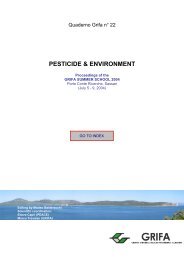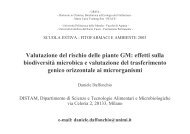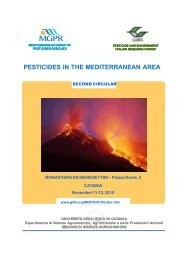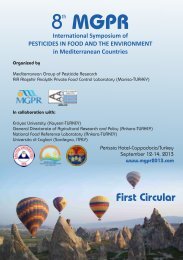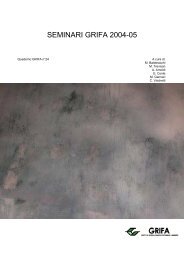International Congress BIOLOGICAL PRODUCTS - Gruppo di ...
International Congress BIOLOGICAL PRODUCTS - Gruppo di ...
International Congress BIOLOGICAL PRODUCTS - Gruppo di ...
Create successful ePaper yourself
Turn your PDF publications into a flip-book with our unique Google optimized e-Paper software.
Several colonies of Lepidopteran, Coleopteran and Dipteran species have been established and are maintained on<br />
a regular basis whereas other species are reared on a temporary basis when needed. Standar<strong>di</strong>zed rearing<br />
procedures have been developed that ensure consistent quality of the test insects.<br />
The following species are currently reared:<br />
Lepidopteran:<br />
Agrotis ipsilon��Mamestra<br />
brassicae, Spodoptera littoralis, S. exigua, Helicoverpa armigera, Lobesia botrana,<br />
Cy<strong>di</strong>a molestaColeopteran:<br />
Otiorhynchus sp., Tenebrio molitorDipteran:<br />
Culex pipiens pipiens<br />
Plant Pathogen Colony Maintainance<br />
Several pathogens are maintained regularly in vitro to support the research and development of bio-phytosanitary<br />
products.<br />
The following fungi species are currently maintained:<br />
Fusarium culmorum, F. crookwellense, F. oxysprum <strong>di</strong>anthii, F. sambucinum, F. solani, F. graminearum, F.<br />
akuminatum, F. oxysporum, Rhizoctonia solani, Alternaria solani, Botrytis cynerea, Penicillum italicum,<br />
Cercospora beticola, Phytophthora cinnamoni, Pyranochaeta lycopersici, Phoma spp., Microdochium nivale<br />
The following phytopathogenic nematode species is currently reared:<br />
Meloidogyne incognita<br />
Greenhouses<br />
Modern and well-equipped greenhouses support the growth of <strong>di</strong>fferent plant species for insect and<br />
phytopathogenic nematode rearing, pathogen maintenance and for glasshouse assays.<br />
The following plants have been grown:<br />
Corn, Melon, Tomato, Pepper, Cyclamen, Impatient, Tobacco, Celery, Rapeseed .<br />
Conclusions:<br />
Due to its facility and its experience, BioTecnologie B.T., is able to design, develop and perform several<br />
bioassays for the development and the quality control of pesticides and biopesticides.<br />
References<br />
Ricci M., Glazer I. and Gaugler R., 1996. Comparison of Bioassays to Measure Virulence of Different<br />
Entomopathogenic Nematodes. Biocontrol Science and Technology (1996) 6, 235-245<br />
Ricci M. and Fridlender B., 1998. Quality Control of a Biological Insecticide Based on Entomopathogenic<br />
Nematodes: NEMA-BIT. At Gent, B: Cost 819 Workshop on Quality Control of Entomopathogenic Nematodes.<br />
p. 16 and 34-35<br />
Robertson J.L. &. Priesler H.K, 1992. Pesticide bioassays with arthropods. CRC Press, Boca Raton.<br />
Pictures<br />
Bioassay Tray: most of the screenings for micro-organisms<br />
and molecules against target insects are carried out in this<br />
particular tray where in<strong>di</strong>vidual insect is tested on an artificial<br />
<strong>di</strong>et<br />
PDF creato con FinePrint pdfFactory versione <strong>di</strong>mostrativa http://www.secom.re.it/fineprint<br />
137



